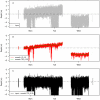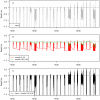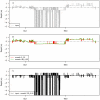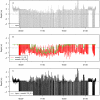Recursive filtering for zero offset correction of diving depth time series with GNU R package diveMove
- PMID: 21297976
- PMCID: PMC3030565
- DOI: 10.1371/journal.pone.0015850
Recursive filtering for zero offset correction of diving depth time series with GNU R package diveMove
Abstract
Zero offset correction of diving depth measured by time-depth recorders is required to remove artifacts arising from temporal changes in accuracy of pressure transducers. Currently used methods for this procedure are in the proprietary software domain, where researchers cannot study it in sufficient detail, so they have little or no control over how their data were changed. GNU R package diveMove implements a procedure in the Free Software domain that consists of recursively smoothing and filtering the input time series using moving quantiles. This paper describes, demonstrates, and evaluates the proposed method by using a "perfect" data set, which is subsequently corrupted to provide input for the proposed procedure. The method is evaluated by comparing the corrected time series to the original, uncorrupted, data set from an Antarctic fur seal (Arctocephalus gazella Peters, 1875). The Root Mean Square Error of the corrected data set, relative to the "perfect" data set, was nearly identical to the magnitude of noise introduced into the latter. The method, thus, provides a flexible, reliable, and efficient mechanism to perform zero offset correction for analyses of diving behaviour. We illustrate applications of the method to data sets from four species with large differences in diving behaviour, measured using different sampling protocols and instrument characteristics.
Conflict of interest statement
Figures







Similar articles
-
Skin temperatures during free-ranging swimming and diving in antarctic fur seals.J Exp Biol. 2000 Jun;203(Pt 12):1907-14. doi: 10.1242/jeb.203.12.1907. J Exp Biol. 2000. PMID: 10821747
-
A Bayesian hierarchical model of Antarctic fur seal foraging and pup growth related to sea ice and prey abundance.Ecol Appl. 2012 Mar;22(2):668-84. doi: 10.1890/11-0102.1. Ecol Appl. 2012. PMID: 22611863
-
Activity-specific metabolic rates for diving, transiting, and resting at sea can be estimated from time-activity budgets in free-ranging marine mammals.Ecol Evol. 2017 Mar 23;7(9):2969-2976. doi: 10.1002/ece3.2546. eCollection 2017 May. Ecol Evol. 2017. PMID: 28479996 Free PMC article.
-
Northern fur seal diving behavior: a new approach to its study.Science. 1976 Jul 30;193(4251):411-2. doi: 10.1126/science.935876. Science. 1976. PMID: 935876 No abstract available.
-
The influence of preceding dive cycles on the foraging decisions of Antarctic fur seals.Biol Lett. 2015 Jul;11(7):20150227. doi: 10.1098/rsbl.2015.0227. Biol Lett. 2015. PMID: 26156132 Free PMC article.
Cited by
-
Foraging flexibility and search patterns are unlinked during breeding in a free-ranging seabird.Mar Biol. 2016;163:72. doi: 10.1007/s00227-016-2826-x. Epub 2016 Mar 14. Mar Biol. 2016. PMID: 27069278 Free PMC article.
-
Digital IIR filters design using differential evolution algorithm with a controllable probabilistic population size.PLoS One. 2012;7(7):e40549. doi: 10.1371/journal.pone.0040549. Epub 2012 Jul 11. PLoS One. 2012. PMID: 22808191 Free PMC article.
-
Interspecific and intraspecific foraging differentiation of neighbouring tropical seabirds.Mov Ecol. 2021 May 26;9(1):27. doi: 10.1186/s40462-021-00251-z. Mov Ecol. 2021. PMID: 34039419 Free PMC article.
-
Two decades of three-dimensional movement data from adult female northern elephant seals.Sci Data. 2024 Dec 18;11(1):1357. doi: 10.1038/s41597-024-04084-4. Sci Data. 2024. PMID: 39695180 Free PMC article.
-
Ecological segregation in space, time and trophic niche of sympatric planktivorous petrels.PLoS One. 2013 Apr 30;8(4):e62897. doi: 10.1371/journal.pone.0062897. Print 2013. PLoS One. 2013. PMID: 23646155 Free PMC article.
References
-
- Laidre KL, Heide-Jørgensen MP, Dietz R. Diving behaviour of narwhals (Monodon monocerus) at two coastal localities in the Canadian Arctic. Can J Zool. 2002;80:624–635.
-
- Spence-Bailey LM, Verrier D, Arnould JPY. The physiological and behavioural development of diving in Australian fur seal (Arctocephalus pusillus doriferus) pups. J Comp Physiol B Biochem Syst Environ Physiol. 2007;177:483–494. - PubMed
-
- Eguchi T, Harvey JT. Diving behavior of the Pacific harbor seal (Phoca vitulina richardsii) in Monterrey Bay, California. Mar Mamm Sci. 2005;21:283–295.
-
- Hull CL. Comparative diving behaviour and segregation of the marine habitat by breeding Royal penguins, Eudyptes schlegeli, and eastern Rockhopper penguins, Eudyptes chrysocome filholi, at Macquarie Island. Can J Zool. 1999;78:333–345.
-
- R development Core Team. Vienna, Austria: R Foundation for Statistical Computing; 2010. R: A language and environment for statistical computing. Available: http://www.R-project.org.
Publication types
MeSH terms
LinkOut - more resources
Full Text Sources

